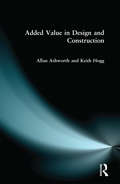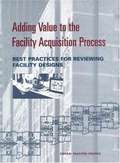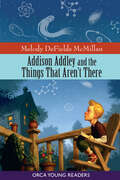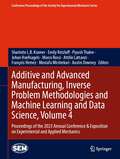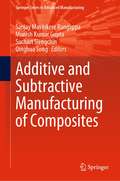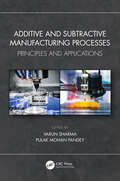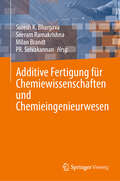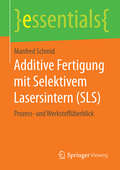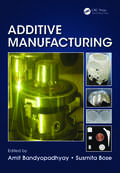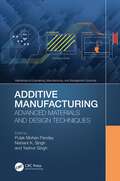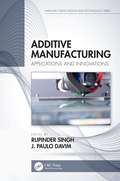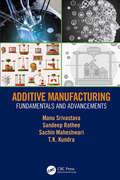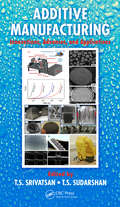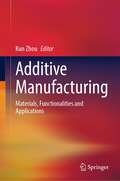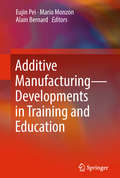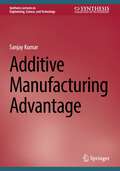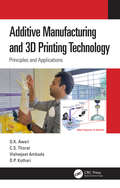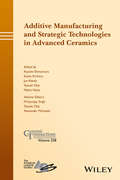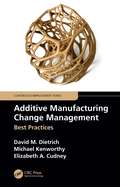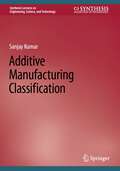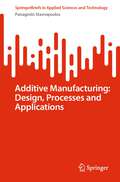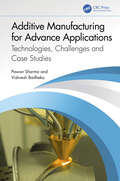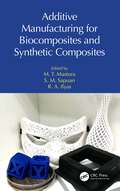- Table View
- List View
Ada's Amazing Ideas
by Liz HuyckAda wants to win a prize one day for her inventions. She has many ideas. When it’s time to clean up her blocks, Ada has a great idea to make clean-up time easier. Ada thinks to use her father’s old socks to invent a way to stay on her two feet on an icy day! Ada’s ideas to recycle old things makes her a great inventor!
Added Value in Design and Construction
by Allan Ashworth Keith HoggAdded Value in Design and Construction takes a holistic, student-centred approach to offering public and private sector clients the ultimate reward; doing more for less. The Latham Report was a call to action and this book provides students of construction with the theoretical and practical knowledge to deliver the recommendations of the report. It describes the principles and techniques crucial to adding value and reducing costs in design and construction in the twenty first century. This book examines in detail a wide range of strategies that can be applied during the design and construction process to add value and bring the best interests of the client sharply into focus.
Addie and Bea Make Adobe
by Amy TaoAddie and Bea use the perfect material to build a house in the desert—adobe!
Adding Value to the Facility Acquisition Process: BEST PRACTICES FOR REVIEWING FACILITY DESIGNS
by Ralph S. SpillingerReport on Adding Value to the Facility Acquisition Process.
Addison Addley and the Things That Aren't There (Orca Young Readers)
by Melody DeFields McMillanAddison Addley hates math. He hates public speaking too. Actually, he hates anything that involves work, but he only has a couple of weeks to write and memorize his grade five speech. The problem is, he can't think of a single topic. When he finally comes up with an excellent idea for a speech, it almost writes itself, but it's his poor math skills that make speech day unforgettable.
Additive and Advanced Manufacturing, Inverse Problem Methodologies and Machine Learning and Data Science, Volume 4: Proceedings of the 2023 Annual Conference & Exposition on Experimental and Applied Mechanics (Conference Proceedings of the Society for Experimental Mechanics Series)
by Sharlotte L. B. Kramer Emily Retzlaff Piyush Thakre Johan Hoefnagels Marco Rossi Attilio Lattanzi François Hemez Mostafa Mirshekari Austin DowneyAdditive and Advanced Manufacturing, Inverse Problem Methodologies and Machine Learning and Data Science, Volume 4 of the Proceedings of the 2023 SEM Annual Conference & Exposition on Experimental and Applied Mechanics, the fourth volume of five from the Conference, brings together contributions to this important area of research and engineering. The collection presents early findings and case studies on a wide range of topics and includes papers in the following general technical research areas: AM Composites and Polymers Dynamic Behavior of Additively Manufactured Materials and Structures Joint Residual Stress and Additive Manufacturing ML for Material Model Identification Novel AM Structures Novel Processing and Testing of Additively Manufactured Materials Plasticity and Complex Material Behavior Virtual Fields Method
Additive and Subtractive Manufacturing of Composites (Springer Series in Advanced Manufacturing)
by Sanjay Mavinkere Rangappa Munish Kumar Gupta Suchart Siengchin Qinghua SongThis book describes crucial aspects related to the additive and subtractive manufacturing of different composites. The first half of this book mainly deals with the various types of composite fabrication methods along with the introduction, features and mechanisms and also the processing of composite materials via additive manufacturing route. Also, the thermal, mechanical, physical and chemical properties relevant to the processing of composite materials are included in the chapters. The second half of this book primarily demonstrates an extensive section on the different types of additive manufacturing processes like selective laser sintering, selective laser melting, stereolithography, fused deposition modeling and material jetting used to fabricate the metals and polymers. Also, the chapters address the complete description of fabrication processes for metal matrix composites and polymer matrix composites. Moreover, the different methods adopted such as short peening, micro-machining, heat-treatment and solution treatment to improve the surface improvement are well discussed. This book gives many helps to researchers and students in the fields of the additive and subtractive manufacturing of different composites.
Additive and Subtractive Manufacturing Processes: Principles and Applications
by Varun Sharma Pulak Mohan PandeyThis reference text discusses fundamentals, classification, principles, applications of additive and subtractive manufacturing processes in a single volume. The text discusses 3D printing techniques with the help of practical case studies, covers rapid tooling using microwave sintering and ultrasonic assisted sintering process, and covers different hybrid manufacturing techniques like cryo-MQL, and textured cutting inserts. It covers important topics including green manufacturing, ultrasonic assisted machining, electro thermal based non-conventional machining processes, metal based additive manufacturing, LASER based additive manufacturing, indirect rapid tooling, and polymer based additive manufacturing. The book- Discusses additive and subtractive manufacturing processes in detail. Covers hybrid manufacturing processes. Provides life cycle analysis of conventional machining. Discusses biomedical and industrial applications of additive manufacturing. The text will be useful for senior undergraduate, graduate students, and academic researchers in areas including industrial and manufacturing engineering, mechanical engineering, and production engineering. Discussing the sustainability aspects of conventional machining in reducing carbon footprint of machining by adopting different hybrid and non-conventional machining processes, this text will be useful for senior undergraduate, graduate students, and academic researchers in areas including industrial and manufacturing engineering, mechanical engineering, and production engineering.
Additive Fertigung für Chemiewissenschaften und Chemieingenieurwesen
by Seeram Ramakrishna Suresh K. Bhargava Milan Brandt Pr. SelvakannanDieses Buch ist speziell für Forscher sowie Lehrende konzipiert, die einen Fortgeschrittenen-Fertigungs-Kurs in ihren Klassen unterrichten oder einführen. Es präsentiert den aktuellen Forschungsstand in diesem Forschungsbereich und die bisher identifizierten Hauptprobleme für die Integration der additiven Fertigung in chemische Prozesse. Die einzigartige Fähigkeit, Materialien mithilfe aufkommender additiver Fertigungstechnologien in funktionale Bauteile mit spezifischer Geometrie zu verwandeln, hat in Biologie, Ingenieurwissenschaften und Materialwissenschaften erhebliches Interesse geweckt, um maßgeschneiderte Designs für spezifische Anwendungen zu erstellen. Die Anwendungen dieses aufstrebenden Fertigungsverfahren im Bereich der chemischen Wissenschaften und des Ingenieurwesens sind im Anfangssdtadium. Daher liegt der Hauptfokus dieses Buches darauf, die grundlegenden Prinzipien der additiven Fertigungsverfahren sowie den Einsatz in konventionelle chemische Prozesse und verschiedeneVerfahrenstechniken einzuführen. Der potenzielle Vorteil der Anwendung dieser additiven Fertigungstechnologien besteht darin, großtechnisch chemische Prozesse herunterzuskalieren, was mehrere Vorteile bietet, darunter eine geringere Flächenbedarf, Abfallreduktion, effiziente Wärmeintegration und dezentrale chemische Fertigung. Was ist Additive Fertigung? Additive Fertigung (engl.: additive manufacturing, AM) – weitgehend auch als 3D-Druck bezeichnet – ist ein aufstrebendes und innovatives Fertigungsverfahren, das sich grundlegend von konventionellen Herstellungsprozessen unterscheidet und der Forschung und Industrie zu völlig neuen Möglichkeiten verhilft. Bauteile werden Schicht für Schicht aufgebaut und entstehen nicht wie bei herkömmlichen Verfahren durch Abtrag von Material (zum Beispiel durch fräsende Bearbeitung). Dadurch ergibt sich eine enorme Flexibilität und Designfreiheit beispielsweise bei der Herstellung von Prototypen und auch zunehmend in der Serienfertigung. Die Zukunft der additiven Fertigung Die additive Fertigung zählt zu den starken Wachstumsfeldern innerhalb der Produktion. Führende Marktberichte sagen ein durchschnittliches jährliches Wachstum von ca. 20 Prozent für die nächsten fünf Jahre voraus. Das Fraunhofer IGCV geht dabei davon aus, dass dieses Branchenwachstum der additiven Fertigung nicht nur in einem spezifischen Industriezweig zu beobachten sein wird. Vielmehr ist davon auszugehen, dass in allen Industriezweigen der Einsatz additiver Fertigungsverfahren zunehmen wird. Im Jahr 2022 wurden zur Zukunft der additiven Fertigung zwei Studien (An Additive Manufacturing Breakthrough & The Futures of Metal Additive Manufacturing 2030) veröffentlicht, bei denen das Fraunhofer IGCV Zuarbeiten geleistet hat. Die additive Fertigung zählt zu den starken Wachstumsfeldern innerhalb der Produktion. Führende Marktberichte sagen ein durchschnittliches jährliches Wachstum von ca. 20 Prozent für die nächsten fünf Jahre voraus. Das Fraunhofer IGCV geht dabei davon aus, dass dieses Branchenwachstum der additiven Fertigung nicht nur in einem spezifischen Industriezweig zu beobachten sein wird. Vielmehr ist davon auszugehen, dass in allen Industriezweigen der Einsatz additiver Fertigungsverfahren zunehmen wird. Im Jahr 2022 wurden zur Zukunft der additiven Fertigung zwei Studien (An Additive Manufacturing Breakthrough & The Futures of Metal Additive Manufacturing 2030) veröffentlicht, bei denen das Fraunhofer IGCV Zuarbeiten geleistet hat.
Additive Fertigung mit Selektivem Lasersintern: Prozess- und Werkstoffüberblick (essentials)
by Manfred SchmidDieses essential stellt das Selektive Lasersintern als Verfahren der additiven Fertigung im Kontext anderer 3D-Druck-Prozesse vor. Manfred Schmid erläutert verschiedene Technologien, die zu den additiven Verfahren gezählt werden, und gibt einen Einblick in die Prozessprinzipien und Werkstoffe. Die grundlegenden Werkstoffvarianten unterschiedlicher Hersteller werden ebenso thematisiert wie die Limitationen des Verfahrens aufgrund reduzierter Bauteildichte und -anisotropie. Das anspruchsvolle Verfahren des Lasersinterns, das die Stufe vom Prototyping zur Produktion überwinden und eine ,,echte" Fertigungstechnologie werden kann, wird detailliert, aber dennoch in kompakter Form beschrieben. Ein Ausblick hinsichtlich bereits vorliegender und gewünschter alternativer Materialien rundet das essential ab.
Additive Manufacturing
by Amit Bandyopadhyay Susmita BoseThe field of additive manufacturing has seen explosive growth in recent years due largely in part to renewed interest from the manufacturing sector. Conceptually, additive manufacturing, or industrial 3D printing, is a way to build parts without using any part-specific tooling or dies from the computer-aided design (CAD) file of the part. Today, mo
Additive Manufacturing: Advanced Materials and Design Techniques (Mathematical Engineering, Manufacturing, and Management Sciences)
by Pulak Mohan Pandey Nishant K. Singh Yashvir SinghThe text explores the development, use, and effect of additive manufacturing and digital manufacturing technologies for diverse applications. It will serve as an ideal reference text for graduate students and academic researchers in diverse engineering fields including industrial, manufacturing, and materials science. This book: Discusses the application of 3D virtual models to lasers, electron beams, and computer-controlled additive manufacturing machines Covers applications of additive manufacturing in diverse areas including healthcare, electronics engineering, and production engineering Explains the use of additive manufacturing for biocomposites and functionally graded materials Highlights rapid manufacturing of metallic components using 3D printing Illustrates production and optimization of dental crowns using additive manufacturing This book covers recent developments in manufacturing technology, such as additive manufacturing, 3D printing, rapid prototyping, production process operations, and manufacturing sustainability. The text further emphasizes the use of additive manufacturing for biocomposites and functionally graded materials. It will serve as an ideal reference text for graduate students and academic researchers in the fields of industrial engineering, manufacturing engineering, automotive engineering, aerospace engineering, and materials science.
Additive Manufacturing: Applications and Innovations (Manufacturing Design and Technology)
by Rupinder Singh and J. Paulo DavimThere has been a great deal of progress in additive manufacturing (AM) during the past two decades and recent developments have been highlighted by many researchers. However, until now, there has been a limit to what is available for beginners in a step-by-step format, showcasing the different commercial AM technologies for field application. This book helps fill that gap. Additive Manufacturing: Applications and Innovations presents case studies of commonly used AM technologies with basic numerical problems for better understanding. It also includes hybrid processes and 4D printing applications, which currently are not offered in other AM books. Features Offers solved and unsolved problems in additive manufacturing Provides an understanding for additive manufacturing per international standards Includes case studies for better understanding of the individual processes Presents a review of specific technology highlights Introduces future research directions, mainly in 4D printing applications
Additive Manufacturing: Fundamentals and Advancements
by Manu Srivastava Sandeep Rathee Sachin Maheshwari Tk KundraThere is a growing need for manufacturing optimization all over the world. The immense market of Additive Manufacturing (AM) technologies dictates a need for a book that will provide knowledge of the various aspects of AM for anyone interested in learning about this fast-growing topic. This book disseminates knowledge of AM amongst scholars at graduate level, post graduate level, doctoral level, as well as industry personnel. The objective is to offer a state-of-the-art book which covers all aspects of AM and incorporates all information regarding trends, historical developments, classifications, materials, tooling, software issues, dynamic design, principles, limitations, and communication interfaces in a one-stop resource. Features: Breaks down systematic coverage of various aspects of AM within four distinct sections Contains details of various AM techniques based on ASTM guidelines Discusses many AM applications with suitable illustrations Includes recent trends in the field of AM Covers engineering materials utilized as raw materials in AM Compares AM techniques with different traditional manufacturing methods
Additive Manufacturing: Innovations, Advances, and Applications
by T. S. Srivatsan T. S. SudarshanGet Ready for the Future of Additive ManufacturingAdditive Manufacturing: Innovations, Advances, and Applications explores the emerging field of additive manufacturing (AM)-the use of 3D printing to make prototype parts on demand. Often referred to as the third industrial revolution, AM offers many advantages over traditional manufacturing. This pr
Additive Manufacturing: Materials, Functionalities and Applications
by Kun ZhouThis book focuses on the advances of additive manufacturing in the applications of wearable electronics, energy storage, biomedical implants and devices, drug delivery, and technologies for 4D printing, large-scale printing, and ceramics printing. It provides timely insights into the materials, functionalities, and applications of additive manufacturing.
Additive Manufacturing – Developments in Training and Education
by Alain Bernard Eujin Pei Mario MonzónThis book provides an overview of training and teaching methods, as well as education strategies, for Additive Manufacturing (AM) and its application in different business sectors. It presents real-world applications and case studies to demonstrate the key practical and theoretical fundamentals of AM training, written by international experts from the field. Additive Manufacturing is a rapidly developing technology, and having a well-trained workforce is essential. Accordingly, readers are introduced to new training approaches and recent breakthroughs that can facilitate and accelerate the design, application and implementation of AM.The book’s contributors discuss many topics to provide readers a fundamental grasp of AM, including:· collaboration among educational bodies, and between industry and governments;· strategies for implementing AM training;· new teaching methods;· training programs that provide alternative employment choices;· the need for certification by professional bodies; and· promoting awareness of AM in society. This book offers an excellent source of information for researchers and industrial engineers who are interested in expanding their AM expertise, and learning how to implement it. It will also be of interest to readers who want to learn about the practicalities of adopting training and teaching for AM.
Additive Manufacturing Advantage (Synthesis Lectures on Engineering, Science, and Technology)
by Sanjay KumarThis book provides a concise introduction to additive manufacturing, accessible to anyone with a basic background in engineering and materials science. The author explains additive manufacturing (AM) in terms of advantages and disadvantages and gives a concise list of advantages and disadvantages, enabling readers to understand AM in relation to other techniques. Additionally, this book clarifies various contradictions with the help of numerous examples.This book:Offers readers a unique, accelerated learning tool, revealing the subtleties of Additive ManufacturingDescribes a concept for refabrication in the context of additive manufacturing, providing new insight into repair and refurbishmentDiscusses additive manufacturing not only as a design tool, but also a production tool in the context of mass-production
Additive Manufacturing and 3D Printing Technology: Principles and Applications
by G. K. Awari C. S. Thorat Vishwjeet Ambade D. P. KothariAdditive Manufacturing and 3D Printing Technology: Principles and Applications consists of the construction and working details of all modern additive manufacturing and 3D-printing technology processes and machines, while also including the fundamentals, for a well-rounded educational experience. The book is written to help the reader understand the fundamentals of the systems. This book provides a selection of additive manufacturing techniques suitable for near-term application with enough technical background to understand the domain, its applicability, and to consider variations to suit technical and organizational constraints. It highlights new innovative 3D-printing systems, presents a view of 4D printing, and promotes a vision of additive manufacturing and applications toward modern manufacturing engineering practices. With the block diagrams, self-explanatory figures, chapter exercises, and photographs of lab-developed prototypes, along with case studies, this new textbook will be useful to students studying courses in Mechanical, Production, Design, Mechatronics, and Electrical Engineering.
Additive Manufacturing and Strategic Technologies in Advanced Ceramics: Ceramic Transactions, Volume 258
by Tatsuki Ohji Alexander Michaelis Kiyoshi Shimamura Makio Naito Mrityunjay Singh Jun Akedo Soshu KiriharaThis volume contains a collection of 22 papers submitted from the below seven symposia held during the 11th International Symposium on Ceramic Materials and Components for Energy and Environmental Applications (CMCEE-11), June 14-19, 2015 in Vancouver, BC, Canada: Additive Manufacturing Technologies Advanced Materials, Technologies, and Devices for Electro-optical and Biomedical Applications Multifunctional Coatings for Energy and Environmental Applications Novel, Green, and Strategic Processing and Manufacturing Technologies Powder Processing Technology for Advanced Ceramics Computational Design and Modeling Materials for Extreme Environments: Ultra-high Temperature Ceramics (UHTCs) and Nanolaminated Ternary Carbides and Nitrides (MAX Phases)
Additive Manufacturing Change Management: Best Practices (Continuous Improvement Series)
by David M. Dietrich Michael Kenworthy Elizabeth A. CudneyAdditive Manufacturing (AM) has altered manufacturing as we know it, with shortened development time, increased performance, and reduced product costs. Executive management in industry are bombarded by marketing from their competitors showcasing design solutions leveraged through AM. Therefore, executive management ask their project management teams to figure out how to utilize AM within their own company. Clueless on how to approach the problem, managers start learning about AM from experts and become overwhelmed at the highly technical information. Unlike other AM books that focus on the technical output of AM technology, this new book focuses solely on the managerial implementation. Features Presents the impacts of AM technology Provides engaging, practical, and entertaining "war stories" from the front line of AM industrialization Describes in detail, the significant hurdles in AM certification and implementation Offers templates of proven change management best practices, as practical solutions Omits the technical verbiage that gets in the way of management understanding how the process is implemented
Additive Manufacturing Classification (Synthesis Lectures on Engineering, Science, and Technology)
by Sanjay KumarAdditive manufacturing classification is one of the biggest issues faced by AM community. The book provides a comprehensive classification of AM, which can be useful to anyone working in any area of manufacturing. As the classification depends on the interrelation of various AM processes, the book provides concise and critical information of those processes, which can be helpful to anyone looking for a concise book on AM. The book provides original information unavailable in research papers.
Additive Manufacturing: Design, Processes and Applications (SpringerBriefs in Applied Sciences and Technology)
by Panagiotis StavropoulosThis book is a comprehensive guide to Additive Manufacturing (AM) product development. It offers a practical, reader-friendly approach to integrating the stages of product development. It covers current design and manufacturing strategies with a step-by-step approach, divided into three pillars: design, processes, and applications.The book addresses the challenges hindering the industrial application of AM and provides a roadmap for its successful implementation. It discusses specific AM case studies and hybrid AM cell and production line setups, with the goal of achieving high-quality, low-cost products that are both flexible and productive. The book concludes with an examination of Industry 4.0 capabilities in decentralized manufacturing.It is aimed to be read by researchers and professionals in industry who are interested in the development and potential of additive manufacturing, and will help to lead to wider adoption of AM.
Additive Manufacturing for Advance Applications: Technologies, Challenges and Case Studies
by Pawan Sharma Vishvesh BadhekaThe book discusses the latest trends such as 4D printing, wire arc additive manufacturing (WAAM), direct energy deposition, and topological optimization in additive manufacturing (AM), and its compliance with the ASTM/ISO standards. It further explains materials for additive manufacturing and the development of novel future materials.The focus of this book is to cover the fundamentals, principles, selection of material and equipment, and applications of additive manufacturing (AM) in a comprehensive manner. It will showcase information about the effective utilization of additive manufacturing for advanced applications in diverse areas such as biomedical, aerospace, automobile, defence, and reverse engineering. The other main features are- · Covers comprehensive discussion on the theoretical aspects of additive manufacturing such as sintering, diffusion, and photopolymerization. · Showcases applications of additive manufacturing in diverse fields including aerospace engineering, automotive engineering, biomedical engineering, and reverse engineering. · Presents case studies to showcase real-time problems and solutions using additive manufacturing. · Includes pedagogical features such as algorithms, exercises, and case studies. The text is primarily written for senior undergraduate, graduate students, and academic researchers in the fields of manufacturing engineering, industrial engineering, production engineering, mechanical engineering, and aerospace engineering.
Additive Manufacturing for Biocomposites and Synthetic Composites
by M. T. Mastura S. M. Sapuan R. A. IlyasAdditive Manufacturing for Biocomposites and Synthetic Composites focuses on processes, engineering, and product design applications of bio-composites and synthetic composites in additive manufacturing (AM). It discusses the preparation and material characterization and selection, as well as future opportunities and challenges. Reviews the latest research on the development of composites for AM and the preparation of composite feedstocks Offers an analytical and statistical approach for the selection of composites for AM, including characterization of material properties Emphasizes the use of environmentally friendly composites Analyzes the lifecycle including costs Considers potential new fibers, their selection, and future applications This book provides a comprehensive overview of the application of advanced composite materials in AM and is aimed at researchers, engineers, and advanced students in materials and manufacturing engineering and related disciplines.

